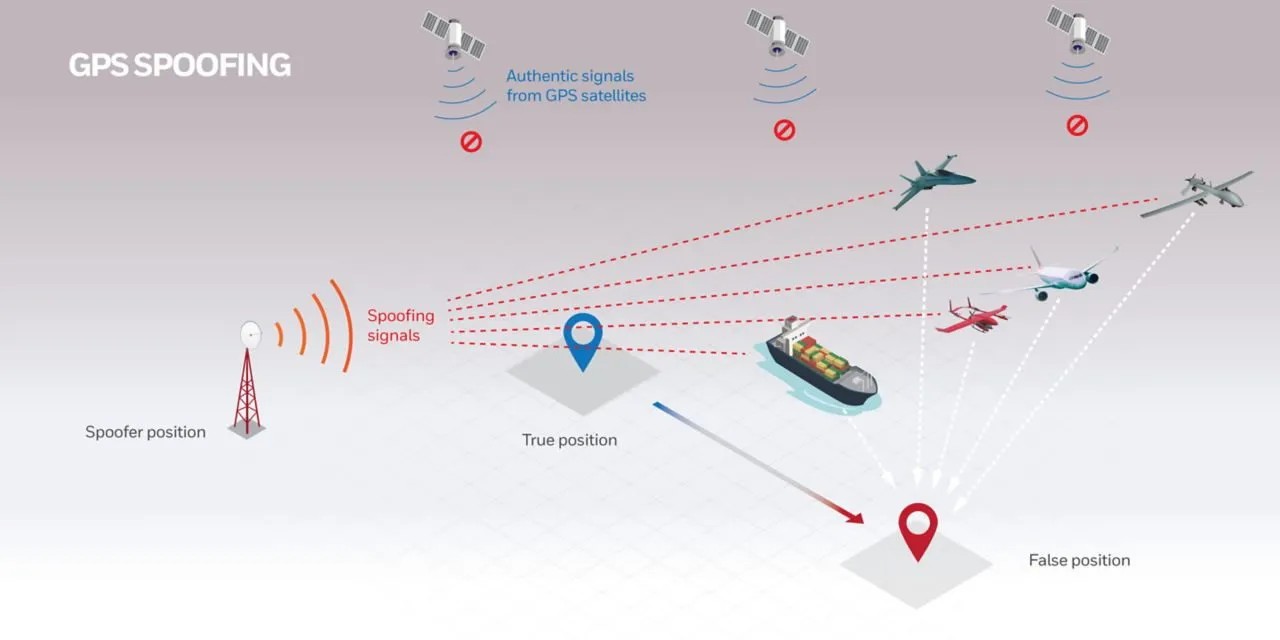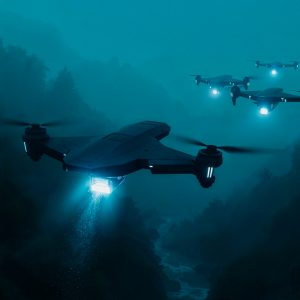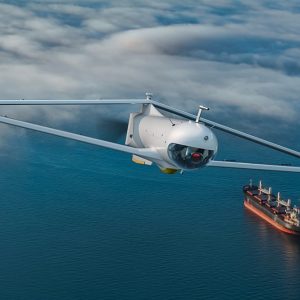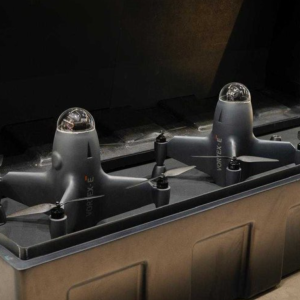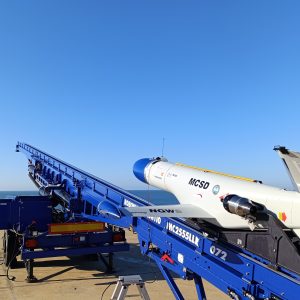As naval operations venture into contested littorals and denied electromagnetic zones, a recent UAV‑hexapod integrated retrieval system promises an innovative tool: deploying a hexapod manipulator from a UAV to execute autonomous retrieval tasks at sea without GNSS. This fusion of aerial robotics and legged manipulation could enable new capabilities for unmanned sustainment, salvage, or sensor recovery in sea zones afflicted by GPS jamming or spoofing.
Key Facts
| Item | Detail |
|---|---|
| Publication | “A Collaborative Team of UAV‑Hexapod for an Autonomous Retrieval System in GNSS‑Denied Maritime Environments” (arXiv preprint, Oct 2024) |
| Demonstrated Concept | UAV carries a winch‑deployed hexapod robot, lands on surface or hovers nearby, then uses manipulator to retrieve payloads or modules while navigating using sensor fusion (optical flow, LiDAR, depth) |
| GNSS‑denial focus | Designed to function without reliance on GPS/GNSS signals, leveraging sensor fusion and relative localization techniques |
| Operational challenge | Maritime environment: waves, motion, unstructured fluid surfaces, communication constraints |
| Coverage | Very limited—aside from the arXiv paper, almost no defence trade coverage to date |
Context
Naval and littoral operations are increasingly challenged by GNSS denial or degradation caused by jamming, spoofing or natural interference. Missions like unmanned logistics, sensor recovery, mine clearance, or emergency salvage must often proceed in degraded navigation regimes.
Simultaneously, unmanned systems proliferate in both aerial and underwater/sea domains. The gap remains in hybrid systems that can carry a manipulator to a remote location, anchor or hover, and perform physical tasks in maritime environments — especially under denied navigation conditions.
While USVs, ROVs, and autonomous surface vehicles are evolving, their ability to self-navigate in denied EMS or execute grasping/retrieval in dynamic sea states is limited. The UAV‑hexapod concept seeks to bridge aerial reach with dexterous manipulation in GNSS‑denied maritime domains.
Because this is still largely academic and experimental, defence journalism has not yet caught up: searches across major outlets yield scarcely any coverage beyond robotics or academic circuits.
New development
In October 2024, researchers published the concept: a collaborative UAV‑hexapod retrieval system intended for maritime operations without GNSS support.
The architecture: a UAV carries a hexapod robot attached via a winch. The UAV releases the hexapod, which descends to the water surface, navigates using sensor fusion (optical flow, LiDAR, depth sensing), and executes manipulator operations — e.g., grabbing a submerged payload or module. Once the mission is done, the hexapod can reattach or be retrieved.
In test (laboratory / scaled water) experiments, the team demonstrated relative localization, manipulation coordination, and robustness to waves and drift. Their results show feasibility under certain controlled conditions, although full sea trials are outstanding.
Additionally, the same research group highlighted that while simulation and model‑scale testbeds are common, maritime autonomy testbeds rarely integrate physical manipulator dynamics + GNSS denial, making this work a novel step.
There is no known procurement or military solicitation yet tied to this concept — it remains at the technology proof‑of‑concept stage.
Technical / Operational implications
Localization & navigation in GNSS denial. Achieving stable hover or station‑keeping in maritime zones without GPS demands fusion of vision, LiDAR, inertial, and possibly acoustic sensors, robust against sea clutter, reflection, and wave motion.
Platform coupling & dynamics. The UAV and hexapod must manage tether dynamics, swing, recoil forces, and maintain stability while the manipulator exerts force on payloads or structure.
Manipulation on a dynamic surface. Grasping or marine docking tasks involve unpredictable surface motion, shifting centers of buoyancy, hydrodynamic drag, and contact uncertainties.
Autonomy and mission sequencing. Decision logic must handle deployment, retrieval, error recovery, communications dropouts, and fault tolerance.
Communications constraints. In contested coastal zones, comms links may be unreliable; operations may require autonomous decision loops onboard.
Power, weight, and energy trade‑offs. Carrying both mobility and manipulation demands careful trade‑offs: battery life, actuator sizing, and payload constraints are challenging in unmanned maritime settings.
Scaling to real sea trials. Laboratory experiments often omit sea state complexity, environmental disturbances, corrosion, salt spray, etc. Field validation will be a major hurdle.
Programme / procurement angle
Currently, this concept is academic and not yet in procurement pipelines. But emerging maritime robotics and naval innovation offices might consider small demonstration contracts, SBIRs or topic calls for UAV‑manipulator systems tailored to sea domain operations.
Navies, coastal forces, and militaries with littoral concerns (e.g. mine warfare, unmanned logistics, sensor recovery) could seed experiments to test these hybrid systems. Early engagement with robotics labs could shape future themes in unmanned maritime R&D.
Defence Agenda will monitor academic conferences (e.g. IEEE ICRA, Oceans) and naval robotics calls to detect when this concept enters formal military interest. See our news and analysis hubs for updates.
Risks / alternatives
- Complexity and failure risk. Integrating aerial mobility, tether dynamics, manipulation, and GNSS denial in a maritime environment is high risk; many proposed modules may not survive rough seas.
- Limited payload scope. Early systems may only handle light loads; heavier tasks (e.g. salvage of large items) may remain out of reach.
- Adversary countermeasures. If communications or sensors are jammed, perception and autonomy may be compromised.
- Alternative means. Subsea or surface robotic vehicles with guided acoustic navigation or onboard localization may serve similar roles without coupling the aerial-manipulator complexity.
- Cost vs benefit. The cost of designing robust hybrid systems might outweigh incremental gains over conventional USVs or ROVs in many use cases.
Implications / Next
If matured, UAV‑hexapod retrieval systems could enable rapid, unmanned maritime recovery, modular payload servicing, sensor redeployment, or salvage in denied navigation zones. That opens new viability for autonomous littoral operations in contested domains.
Labs, navies, and defence innovation offices should consider funding small-scale sea trials, instrumenting maritime testbeds for manipulation + autonomy, and exploring transition paths to naval unmanned systems portfolios.
Defence Agenda will publish follow‑on briefings, detect solicitations that reference these motifs, and compare allied developments in maritime robotic manipulation. Stay tuned via our news hub and naval robotics analysis streams.
Further Reading
- Internal: Defence Agenda — News hub: defenceagenda.com/news
- Internal: Defence Agenda — Analysis hub: defenceagenda.com/analysis
- External: ArXiv preprint “A Collaborative Team of UAV‑Hexapod for an Autonomous Retrieval System in GNSS‑Denied Maritime Environments”
- External: ArXiv “Digital‑physical testbed for ship autonomy studies” as an example of maritime test infrastructure challenges

